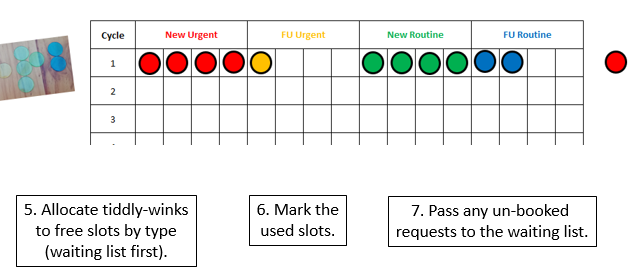This is the name given to an endemic, chronic, systemic, design disease that afflicts the whole NHS that very few have heard of, and even fewer understand.
This week marked two milestones in the public exposure of this elusive but eminently treatable health care system design illness that causes queues, delays, overwork, chaos, stress and risk for staff and patients alike.
The first was breaking news from the team in Swansea led by Chris Jones.
They had been grappling with the wicked problem of chronic queues, delays, chaos, stress, high staff turnover, and escalating costs in their Chemotherapy Day Unit (CDU) at the Singleton Hospital.
The breakthrough came earlier in the year when we used the innovative eleGANTT® system to measure and visualise the CDU chaos in real-time.
This rich set of data enabled us, for the first time, to apply a powerful systems engineering technique called counterfactual analysis which revealed the primary cause of the chaos – the elusive and counter-intuitive design disease carvoutosis multiforme fulminans.
And this diagnosis implied that the chaos could be calmed quickly and at no cost.
But that news fell on slightly deaf ears because, not surprisingly, the CDU team were highly sceptical that such a thing was possible.
So, to convince them we needed to demonstrate the adverse effect of carveoutosis in a way that was easy to see. And to do that we used some advanced technology: dice and tiddly winks.
The reaction of the CDU nurses was amazing. As soon as they ‘saw’ it they clicked and immediately grasped how to apply it in their world. They designed the change they needed to make in a matter of minutes.
But the proof-of-the-pudding-is-in-the eating and we arranged a one-day-test-of-change of their anti-carveout design.
The appointed day arrived, Wednesday 19th June. The CDU nurses implemented their new design (which cost nothing to do). Within an hour of the day starting they reported that the CDU was strangely calm. And at the end of the day they reported that it had remained strangely calm all day; and that they had time for lunch; and that they had time to do all their admin as they went; and that they finished on time; and that the patients did not wait for their chemotherapy; and that the patients noticed the chaos-to-calm transformation too.
They treated just the same number of patients as usual with the same staff, in the same space and with the same equipment. It cost nothing to make the change.
To say they they were surprised is an understatement! They were so surprised and so delighted that they did not want to go back to the old design – but they had to because it was only a one-day-test-of-change.
So, on Thursday and Friday they reverted back to the carveoutosis design. And the chaos returned. That nailed it! There was a riot!! The CDU nurses refused to wait until later in the year to implement their new design and they voted unanimously to implement it from the following Monday. And they did. And calm was restored.
The second milestone happened on Thursday 11th July when we ran a Health Care Systems Engineering (HCSE) Masterclass on the very same topic … chronic systemic carveoutosis multiforme fulminans.
This time we used the dice and tiddly winks to demonstrate the symptoms, signs and the impact of treatment. Then we explored the known pathophysiology of this elusive and endemic design disease in much more depth.
This is health care systems engineering in action.
It seems to work.

